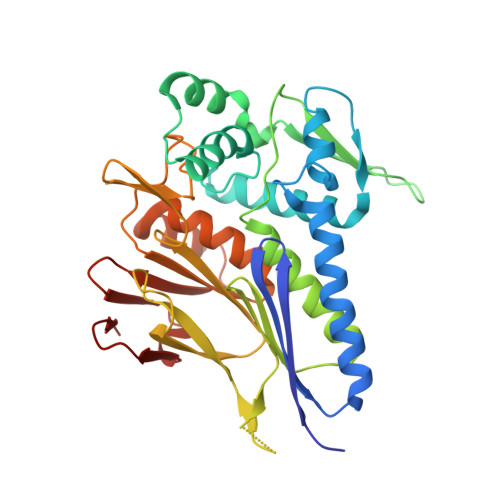The TP0796 Lipoprotein of Treponema pallidum Is a Bimetal-dependent FAD Pyrophosphatase with a Potential Role in Flavin Homeostasis.
Deka, R.K., Brautigam, C.A., Liu, W.Z., Tomchick, D.R., Norgard, M.V.(2013) J Biol Chem 288: 11106-11121
- PubMed: 23447540
- DOI: https://doi.org/10.1074/jbc.M113.449975
- Primary Citation of Related Structures:
4IFU, 4IFW, 4IFX, 4IFZ, 4IG1 - PubMed Abstract:
Treponema pallidum, an obligate parasite of humans and the causative agent of syphilis, has evolved the capacity to exploit host-derived metabolites for its survival. Flavin-containing compounds are essential cofactors that are required for metabolic processes in all living organisms, and riboflavin is a direct precursor of the cofactors FMN and FAD. Unlike many pathogenic bacteria, Treponema pallidum cannot synthesize riboflavin; we recently described a flavin-uptake mechanism composed of an ABC-type transporter. However, there is a paucity of information about flavin utilization in bacterial periplasms. Using a discovery-driven approach, we have identified the TP0796 lipoprotein as a previously uncharacterized Mg(2+)-dependent FAD pyrophosphatase within the ApbE superfamily. TP0796 probably plays a central role in flavin turnover by hydrolyzing exogenously acquired FAD, yielding AMP and FMN. Biochemical and structural investigations revealed that the enzyme has a unique bimetal Mg(2+) catalytic center. Furthermore, the pyrophosphatase activity is product-inhibited by AMP, indicating a possible role for this molecule in modulating FMN and FAD levels in the treponemal periplasm. The ApbE superfamily was previously thought to be involved in thiamine biosynthesis, but our characterization of TP0796 prompts a renaming of this superfamily as a periplasmic flavin-trafficking protein (Ftp). TP0796 is the first structurally and biochemically characterized FAD pyrophosphate enzyme in bacteria. This new paradigm for a bacterial flavin utilization pathway may prove to be useful for future inhibitor design.
Organizational Affiliation:
Department of Microbiology, University of Texas Southwestern Medical Center, Dallas, Texas 75390, USA.

















